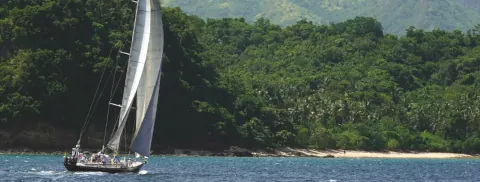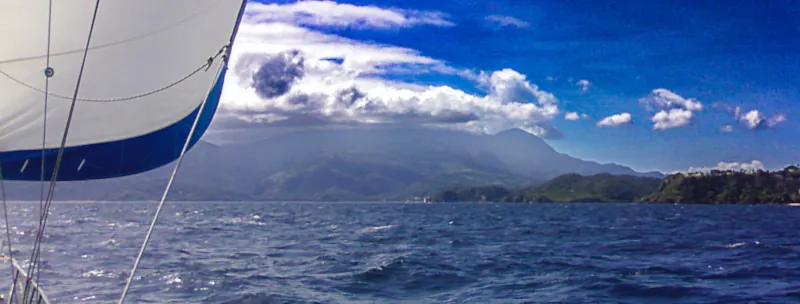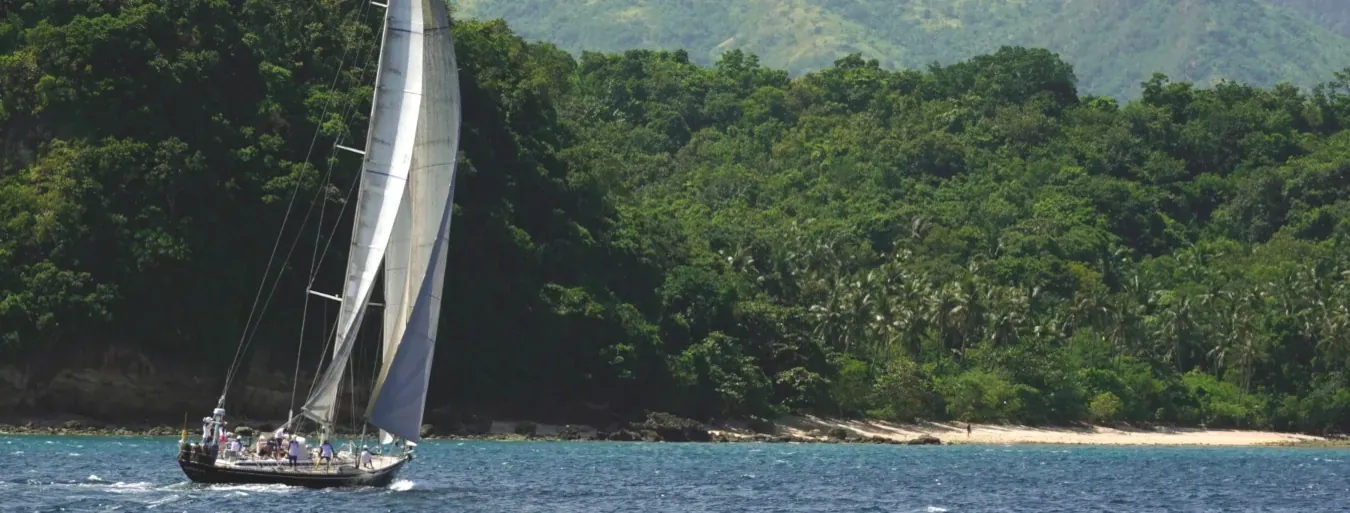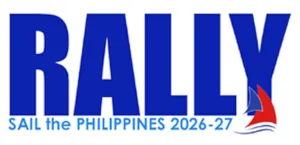Sail Around Mindanao
The length of "Mindanao's" coastline is one of the longest of any island anywhere in the World, at a reported 19,560 nautical miles. You will probably not want to explore its entirety but there are some significant destinations that should be on your Philippine bucket list.
Southern Mindanao
Because of its low latitudes Southern Mindanao is considered "Typhoon Safe". As a result you can sail and anchor almost anywhere and not worry about finding bolt-holes to ride out a storm. That does not mean there is no wind or rain (there are occasional thunderstorms, etc.) it just means that the risk to life, limb and your yacht is really down to your experience of sailing.
Sarangani Bay
Sarangani Bay is the southernmost bay in Mindanao and probably the most westerly that you will want to sail to along the South coast. At the head of the Bay is General Santos City (locally "Gen San") also know as the "Tuna Capitol of The Philippines"; in fact the dressing, canning and freezing of seafood has developed here to become a major export industry for the City. The agricultural land in the vicinity of Gen San is perfect for growing pineapples and this is the centre for Dole's Asian pineapple production - another significant export income earner for the Philippines. Gen San has also become famous more recently because it is the birthplace and home of World-champion boxing idol (now businessman and politician) Manny "PacMan" Pacquiao
You can anchor along the East or the West coast of Sarangani Bay. The East coast features many sandy beaches with resorts while the West coast is a little more rugged but still offers good anchorage and access to habitations.
From Gen San overland you can access some of the most interesting, culturally significant and historic locations in southern Mindanao: spectacular Lake Sebu, home of indigenous T'Boli tribe; Maitum, where ancient burial rites record the faces and character of those who have passed in sculpted earthenware jars, where each jar is the repository of the bones of the individual; multiple river experiences such as waterfalls, rafting and tubing; and, mountain trekking Mount Matutuam (the tallest volcano in Southern Mindanao) or Mount Melibengoy, known as home to indigenous butterflies and Philippine tarsiers plus featuring the crystal clear waters of Lake Holon embraced within its crater.
Sailing East from Sarangani Bay you enter the Davao Gulf.
The Davao Gulf
The Davao Gulf offers a vast expanse of water and a long, anchorable coastline, with cities, towns and villages around its perimeter. The Davao Gulf itself is known as a breeding ground for whale sharks, bottlenose dolphins and sperm whales.
If entering from Sarangani Bay then the first city is Digos City - capitol of Davao del Sur province. Digos City and its surrounding rolling hills and mountains is largely an agricultural center for export of mango and cacao. Digos has recently claimed the title of "The Mango Capitol of The Philippines" from the former Visayan island of Guimaras; the predominant mango grown here is the deliciously sweet 'carabao mango'.
One of the dominant features of the skyline to the North of Digos is Mount Apo, the highest mountain in the Philippines, topping out at 2,954 meters. You can overland to Mount Apo and there are organized treks to its sulfur coated summit.
As you voyage northeast from Digos you will find Samal Island and Davao City. Davao City is a check-in check-out port for yachts arriving and departing the Philippines, especially those voyaging from / to Australia or Indonesia, and is considered to be one of the safest cities in Asia for tourists. The Port of Davao is Mindanao's largest port and is usually busy with container ships and ferries, so most visiting yachts will prefer to anchor off the West coast of Samal Island. Of interest perhaps is the sailing club on the West coast of Samal Island and the marina located on the North coast - see the Sailing Clubs Philippines and the Marinas Moorings Repairs pages for details
Davao City is also the location of Davao International Airport, with flights from Singapore Airlines and Quatar Airways connecting it to the World.
The Kadayawan Festival happens every August and is Davao City's celebration of its founding - a time for the indigenous tribes of Southern Mindanao to showcase their unique cultures and artisty. It is also the time of year to enjoy the predominant harvest of the iconic durian fruit.
Samal Island is famous with bat lovers for it is the home of the World's largest colony of Geoffroy's Rousette Old World fruit bat. The Monfort Bat Colony cave on Samal Island is reported in the Guinness Book of Records and is home to an estimated 2.5 Million Geoffroy's Rousette bats. On any evening the sky will be filled with the emergence of the majority of the bats, as they exit the cave and fly towards flowering and fruiting trees around the Gulf; the Geoffroy's Rousette bat is responsible for pollination and seed dispersal giving Davao the widest variety of fruits for sale.
Onward West from Davao and Samal the coastline is largely lowland but with mountains and limestone escarpments as backdrop. The lowlands are dominated by banana production, where the World famous Cavendish banana variety is grown for export, while the mountains and, in particular, the limestone escarpments offer some fascinating caving (spelunking) opportunities . . . anchor off Tagum City and contact the municipal tourism office for caving adventures.
The East coast of the Davao Gulf has numerous small islands with pretty beaches and a handful of resorts. Not as frantic as the waters around the West and North of the Gulf, the East coast offers many tranquil anchorages. As you approach the southeastern exit of the Gulf you will notice the mountainous peninsula featuring Mount Hamiguitan and its Wildlife Sanctuary. The Wildlife Sanctuary is one of the few remaining places where the critically endangered, Philippine Eagle flies safe and free. The Philippine Eagle is considered to be the largest eagle in the World, in terms of overall length and wing surface area, but has suffered from a century of habitat destruction as the Philippines' once heavily forested mountains have been plundered for timber export. Maybe visiting the Sanctuary and having the opportunity to see these magnificent birds will be high on your Philippine bucket-list.
As you exit the Davao Gulf you will be leaving its relatively flat waters and start catching the lumpier waters of the Celebas Sea. The San Augustine peninsula has two more delights to offer that you may wish to explore: a rare pink sand beach just a short walk from the triple lighthouse structures at the "Parola". The three lighthouse towers (only one of which is now working) span more than 100 years of history: from the Spanish occupation, to the American occupation, to the modern day - solar powered and fully automated.
Eastern Mindanao
On Mindanao's eastern seaboard the first notable town is Mati, at the head of Pujada Bay. Many visitors have said that Pujada Bay is 'the most beautiful bay in the World' because the scenary features a largely unspoilt combination of beaches, rolling hills and forested mountains, all filled with Mother Nature's creations.
You can expore Pujada Bay and anchor off the town of Mati or your can bypass the Bay and sail on to Dahican Beach; still part of the municipality of Mati but facing southeast across the Celebas Sea towards the Pacific Ocean. Dahican Beach is known for surfing, skim-boarding and turtles. Dahican Beach is a good place to learn to surf or skim-board because the waves are relatively predictable and not too large. For turtles, the beach offers a wide area for digging a nest and laying eggs, with a fairly gentle downhill slope for newly-born hatchlings to descend to start their own Pacific Ocean adventures.
An important note here: the East coast of Mindanao is affected by the "Mindanao Current" that predominantly flows North to South offshore. The Mindanao current is probably due to the entire Pacific Ocean attempting to force it way through the two narrow straits (Surigao Strait and San Bernadino Strait), and around the North of Luzon and the South of Mindanao, in is effort to follow the moon's attraction. Best advice is to sail close to shore where possible, to stay out of the Mindanao Current when sailing northward.
After Mati you are now enjoying the magnificent mountain views on port and the unfathomable Pacific Ocean on starboard. Probably your next significant stop will be Bislig Bay, if for no other reason than you want to buy some supplies (especially seafood) and rest in a truly sheltered anchorage on its North shore. If you are into waterfalls then Bislig offers easy road access to at least half-a-dozen, including the Tinuy-an Falls - one of the tallest and widest waterfalls in the Philippines. However, if you are into beaches then you may have noticed or stopped at a couple of very long beaches, with very few people, at Baganga and Cateel.
Cateel is notable in recent times for being the landing place of one of the World's strongest tropical storms to make landfall anywhere on the planet. Super Typhoon Bopha (locally Pablo) made landfall just South of Cateel as a Category 5 Super Typhoon with winds of 175 mph (282 km/h) on December 3, 2012. Not only was it one of the strongest at landfall, it was also notable because of the low latitudes and rapid intensification from formation through to landfall.
You could say that once you have reached Cateel northbound then you are in the "typhoon belt", although to be honest: (a) very few storms ever come close to that far South; and, (b) the handful of storms (over the past 40 years) that have approached Bopha's low latitude and strength, have only occured in mid-November to early December.
After Bislig there are many inlets and islands to explore along the way if the passion takes you, all the way North to Lanuza Bay, with its 12Km long, black sand beach facing the NE monsoon and thus offering an almost perfect surf break.
After Lanuza Bay you have a choice to make: North to Bucas Grande and Siargao islands, or northwest towards Surigao City and the Surigao Strait.
If you choose to go North you can always go West later. Whichever you choose you will notice the ravaged hillsides and mountains above the North shore of Lanuza Bay. Unfortunately strip-mining has been apparent here for decades, in the search for minerals found nowhere else at the low cost of extraction that the Philippines features.
North to Bucas Grande & Siargao Islands
Busas Grande presents a maze of inlets, small bays and islands. It is largely undeveloped and has retained many unique wildlife habitats. Bucas Grande features the Sohoton National Park. Within the expanse of the Sohoton Park is the jellyfish sanctuary. Unique in that you can swim within Sohoton Cove with scores or thousands (depends on the season - March to May best) of stingless jellyfish.
Siargao Island is recognized as one of the World's top ten surfing destinations, largely because of the perfect tube that the "Cloud 9" surf break offers on Siagao's East coast, just North of General Luna town. In addition to surfing, the East of Siagao Island offers kiteboard, windsurf, scuba dive, snorkeling or you can enjoy some top-flight game-fishing for marlin, sailfish and dorado / mahi-mahi over the Philippine Deep (second deepest ocean trench on the planet, reaching 10,540 meters) - boats with gear and guides for hire out of Port Pilar.
The West side of Siargao Island has large areas of mangroves that you can kayak through to observe a wide variety of bird and reptile life. Also in the mangroves are indigenous Philippine crocodiles as well as saltwater crocodiles.
Northwest to Surigao City
From Lanuza Bay the strip-mining comes into clear view where the hillsides of this part of Surigao del Sur province have been raped for the nickel and copper ore they contain. You probably do not want to stop too many places here after Ayuki Island and General Island, until you reach Lapinigan Island and beyond.
If you are running short of rum aboard then the town of Gigaquit (pronounced he-ga-kit), Surigao del Norte, has a rather unique solution and is well worth a visit. As well as offering a very sheltered river estuary anchorage, the town has many nipa palms growing in the wetlands; harvesting the young nipa for the purpose of fermentation produces a white rum that is rated as equal, if not superior, to Bacardi Rum. If you purchase Gigaquit Rum in Gigaquit then the price makes it three to four times more attractive than the Bacardi equivalent plus, you will be helping the local economy and saving all the carbon dioxide that would otherwise be required to ship Bacardi to you from its source.
After Gigaquit there is a maze of islands ahead that span the waters between Surigao City and Dingat Island. There is no one correct or fastest passage to take and, you can pass between any or all the islands if your yacht has a draft of less that 6 meters (according to Navionics charts). On entering Canal Bay, the deepest passage through the maza to Surigao City (mostly 100+ meters depth all the way) will be found by leaving Masapelid Island to starboard, then leaving Condona Island to port, then Bilabid Island to starboard and finally Lamagon Island to port. Some of the islands are tall and some not so tall so, depending on the wind on the day, you should expect some motor sailing, so be sure to top-up your fuel tank in Gigaquit before heading out.
As you leave Lamagin Island astern Surigao City is almost due West and there is only the island of Kabo to negotiate. You can pass clear North of the island or through the passage between it and Load Island (11+ meters according to Navionics charts).
Throughout the island maze you should keep your eyes open for different seabirds for, in addition to the Brahminy Kite, the white-breasted sea eagle (Haliaeetus leucogaster) is also resident in the vicinity, and you may see different species of boobies and terns. The waters are abundant with juvenile fish and the islands for nesting are very close, so life is generally good for seabirds here.
Surigao To Butuan
The Port of Surigao has recently become a fully yacht-friendly port with the direct involvement of the Department of Tourism and local water sports enthusiasts wishing Surigao to become the premier check-in/out port on the East coast of the Philippines. If you have questions about anything to do with Surigao del Sur and its many diverse island communities then this is the place to anchor. Please see the Entry & Exit section of this website for contact information.
One other possible reason to stay a few days in Surigao City is to explore Lake Mainit (pronounced with three sylables ma-in-it), to the South of Surigao City by road. Lake Mainit is notable as the deepest freshwater lake in the Philippines (around 220 meters) and it is the fourth largest lake by area (17,060 ha). Within the vicinity of the lake live four Philippine birds endemic to Mindanao, including: an owl, a nightjar and a kingfisher. The lake is home to resident freshwater fish and migratory fish that enter the lake seasonally from the Kalinawan River, which connects the lake to the sea near Butuan. There are 28 rivers and streams that feed Lake Mainit and along its eastern shore are multiple waterfalls to enjoy among the forested hills. Well worth a stopover!











